Search
All results
(726)
MediaInfos
(251)
News
(2)
BasicInfos
(10)
Press kits
(5)
Images
(200)
Videos
(74)
Publications
(20)
Technical Details
(40)
 Environmental declaration Neckarsulm 2024 (in national language)
Environmental declaration Neckarsulm 2024 (in national language)
Audi Standort Neckarsulm Aktualisierte Umwelterklärung 2024 2 Inhalt 3 4 Wassernutzung Verantwortungsvoller Umgang mit der Ressource Wasser 6 Umweltauswirkungen des Standortes Impact-Points Audi Neckarsulm 2023 Wasserkreislauf Nachhaltige Wassernutzung in der Fertigung 8 16 Umweltauswirkungen des Standortes Gefährliche Abfälle/Entwicklung der Kernindikatoren (R) 10 Vorstellung des Standortes Entwicklung der Kernindikatoren (A/B) 14 Modernisierung Innovative Technologien für geringeren Wasserverbrauch 18 Upcycling Ausgedienter Kältemitteltank wird zum Regenwasserspeicher 21 Umweltprogramm Umweltziele 2023–2025 22 Gültigkeitserklärung/Zertifikat Ansprechpartner Audi A5 Avant TFSI quattro 150 kW: Kraftstoffverbrauch kombiniert in l/100 km: 7,9–7,1; CO₂-Emissionen kombiniert in g/km: 179–161; CO₂-Klasse: G–F 4 5 Im Fokus: Verantwortungsvoller Umgang mit der Ressource Wasser tion und Logistik gebündelt werden. Neben Biodiversität, Dekarbonisierung und Ressourceneffizienz steht die Wassernutzung im Werk weit oben auf der Agenda. Um Wasser bewusst und sparsam zu verwenden, setzt Audi am Standort Neckarsulm auf Audi steht für einen vorausschauenden und sparsamen Umgang mit Ressourcen. Ein maßgeblicher Baustein für diese Zielsetzung ist das Umweltprogramm „Mission : Zero“, in dem sämtliche Ansätze zur Reduzierung des ökologischen Fußabdrucks in Produkvielfältige Maßnahmen und Projekte. Wirksame Beispiele sind der im Aufbau befindliche Wasserkreislauf, effiziente Prozesse in der Lackiererei und die verstärkte Nutzung von Regenwasser auf dem Werksgelände. Audi Q6 SUV e-tron quattro: Stromverbrauch (kombiniert): 19,6–17,0 kWh/100 km; CO₂-Emissionen (kombiniert): 0 g/km; CO₂-Klasse: A, 02.07.2024 6 IMPACT-POINTS AUDI NECKARSULM 2023 Umweltauswirkungen des Standortes 7 Die Umweltauswirkungen des Standortes Neckarsulm wurden mit der Impact Points Methode bewertet. Umweltauswirkungen des Standorts in Mrd.
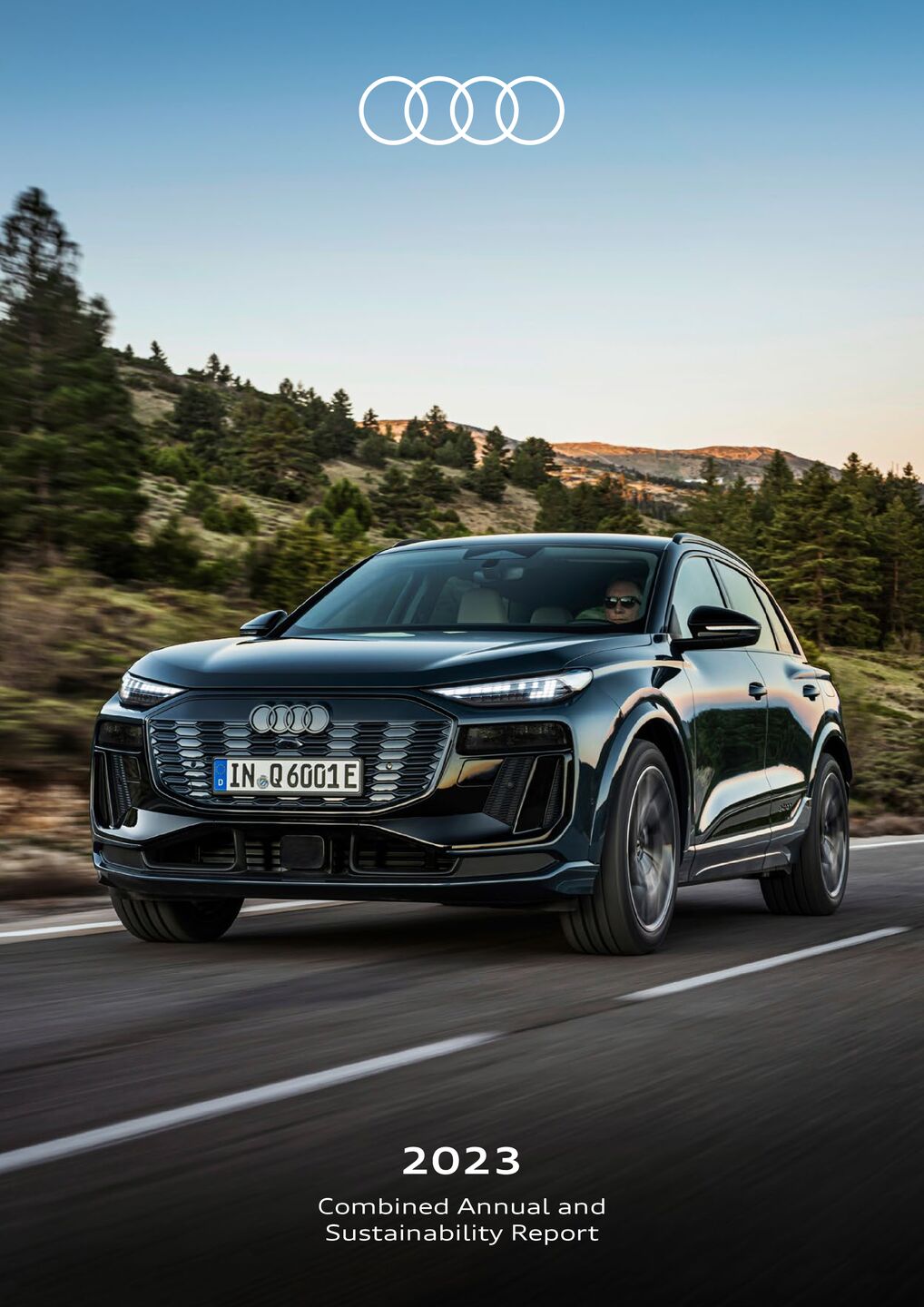 2023: Combined Annual and Sustainability Report
2023: Combined Annual and Sustainability Report
The allroad, PHEV and CNG (g-tron) models are not declared specifically. ⁴ Sites as of December 31, 2023. The production site in Córdoba (VW Argentina S.A.) is a new addition in the reporting period. The production site in Kaluga is no longer included. GRI 2-1, GRI 2-6 13 countries 22 production sites Overview of deliveries to customers 2023³ 1,895,240 (1,614,231) 13,560 (15,174) 10,112 (9,233) 58,224 (61,562) Overview of deliveries to customers 2023³ https://www.audi.com/content/dam/gbp2/downloads/report/interim-reports/2023/audi-fact-pack-q4-2023.xlsx Strategy & Company Finance ESG Appendix 6 Audi Report 2023 Ill us tr at io n: C 3 V is ua l L ab Europe A B C D E F G H I J 1,107,364 Cars produced: 45,621 Motorcycles produced: 13,241 Crewe, United Kingdom Bentley Motors Ltd. Bentayga Continental GT, Continental GTC Flying Spur A 101,145 Zwickau, Germany Volkswagen AG Q4 e-tron Q4 Sportback e-tron D 64,890 Martorell, Spain, SEAT, S.A. A1 allstreet A1 Sportback RS 3 Sedan J 403,874 Ingolstadt, Germany AUDI AG A3 Sedan, S3 Sedan, RS 3 Sedan A3 Sportback, S3 Sportback, RS 3 Sportback A4 allroad quattro A4 Avant, S4 Avant, RS 4 Avant A4 Sedan, S4 Sedan A5 Coupé, S5 Coupé, RS 5 Coupé A5 Sportback, S5 Sportback, RS 5 Sportback Q2, SQ2 Q6 e-tron, SQ6 e-tron E 121,418 Bratislava, Slovakia VOLKSWAGEN SLOVAKIA, a.s. Q7, SQ7 Q8, SQ8, RS Q8 F 176,493 Győr, Hungary, Audi Hungaria Zrt. Q3, RS Q3 Q3 Sportback, RS Q3 Sportback TT Coupé, TTS Coupé, TT RS Coupé TT Roadster, TTS Roadster, TT RS Roadster G 53,555 Brussels, Belgium AUDI BRUSSELS S.A./N.V. e-tron, e-tron S e-tron Sportback, e-tron S Sportback Q4 e-tron Q8 e-tron, SQ8 e-tron Q8 Sportback e-tron, SQ8 Sportback e-tron B 10,014 Sant’Agata Bolognese, Italy Automobili Lamborghini S.p.A. Aventador Coupé, Aventador Roadster Huracán Coupé, Huracán Spyder Revuelto Coupé Urus H 45,621 Bologna, Italy Ducati Motor Holding S.p.A.
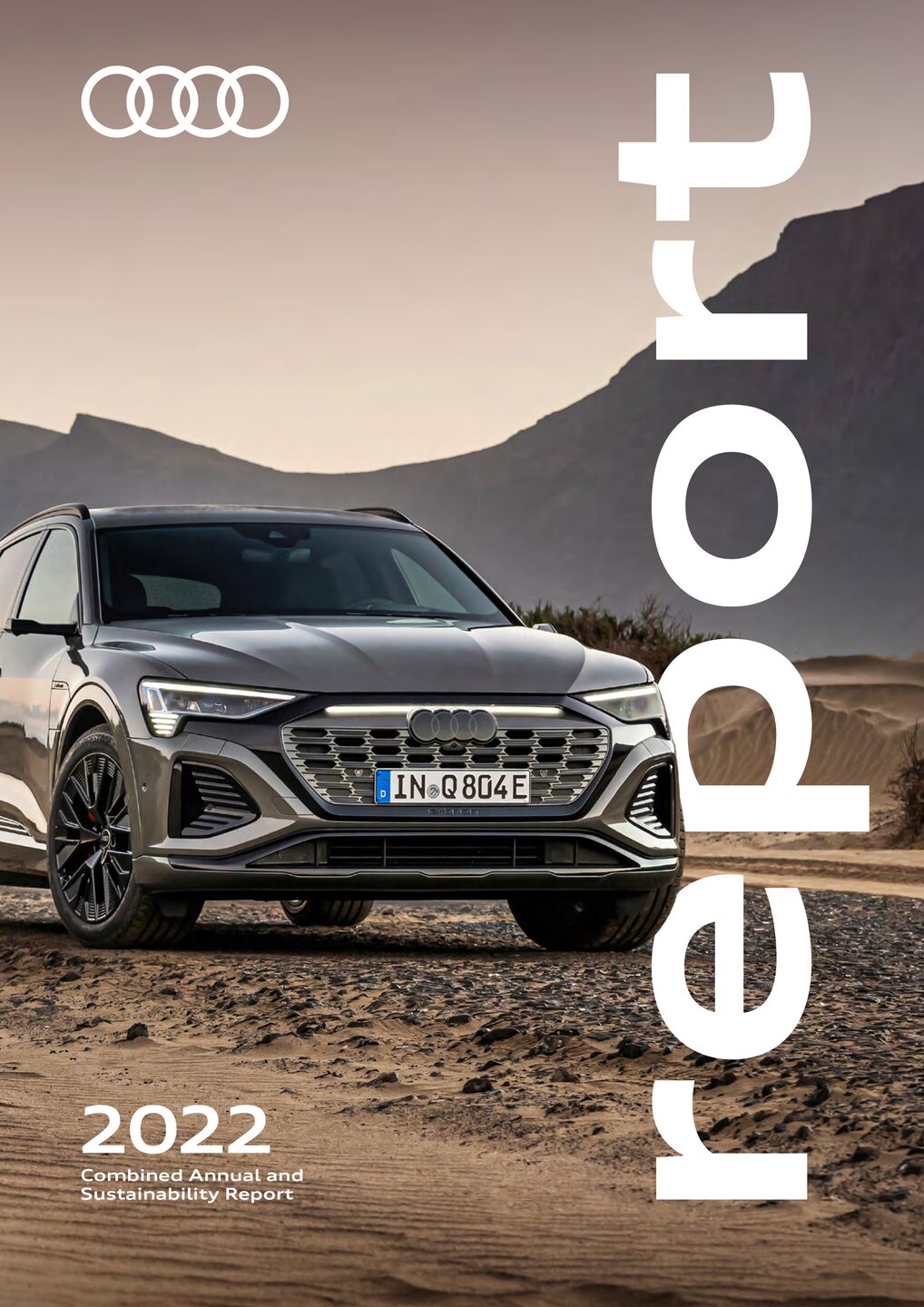 Audi Report 2022
Audi Report 2022
The allroad, PHEV and CNG (g-tron) models are not declared specifically. ⁴ The Bentley brand was consolidated effective January 1, 2022. The production and delivery figures include models of the Bentley brand for the first time in 2022. The number of employees also includes employees of the Bentley brand for the first time. ⁵ Sites as of December 31, 2022. ⁶ Production of semi-knocked-down (SKD) vehicles. With this procedure, the cars are completely assembled to start with. Then they are partially dismantled and transported as kits to Kaluga or São José dos Pinhais. Assembly is carried out in accordance with the technical and quality specifications of AUDI AG. ⁷ Production from January to March 2022.
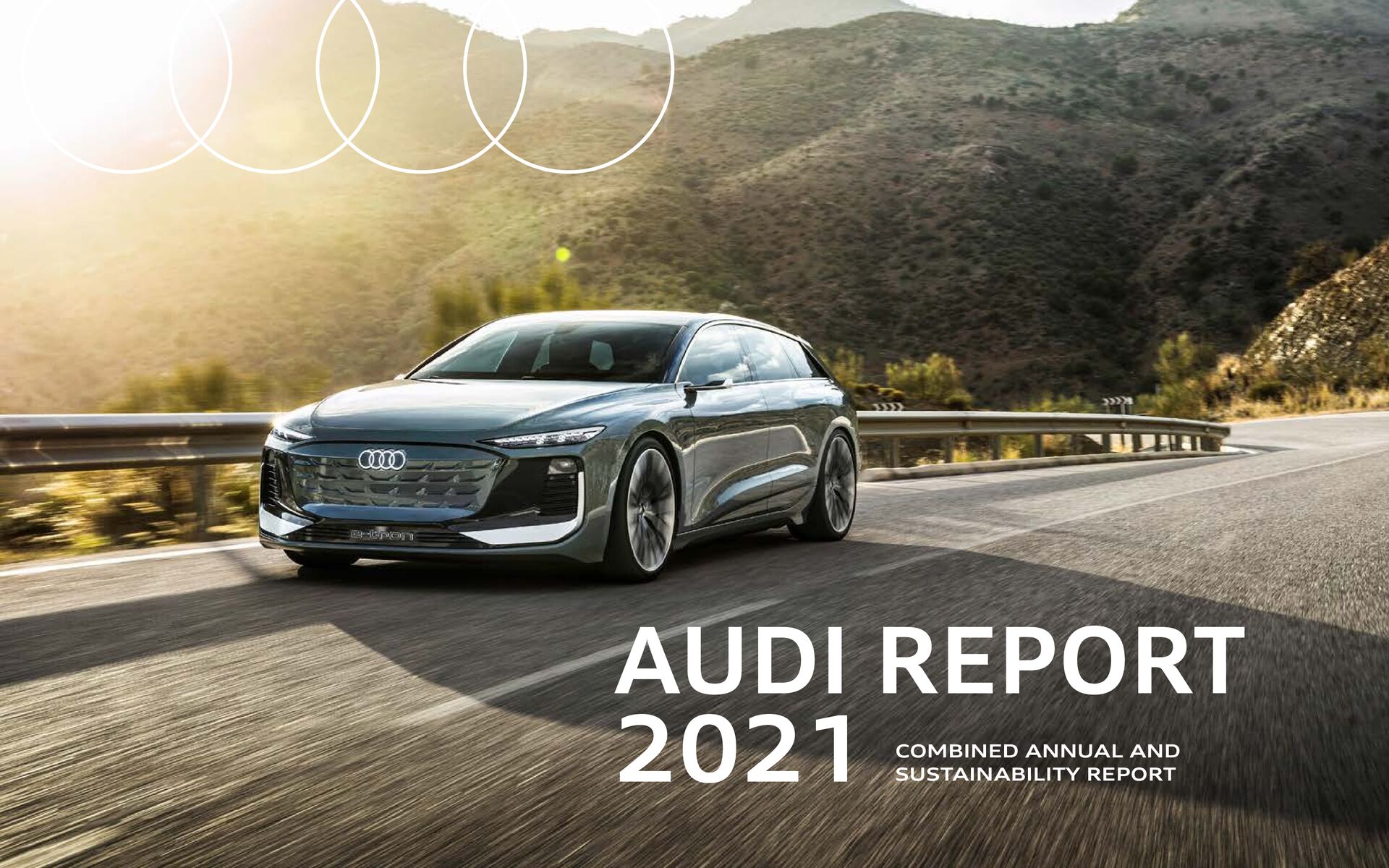 Audi Report 2021
Audi Report 2021
Series production of the new fully electric Audi Q4 e-tron model line started at the Volkswagen multi-brand site in Zwickau in the first quarter of 2021. A total of 27,696 vehicles of the Audi brand were produced there in the reporting period. In Europe, higher production was also reported by the sites in Hungary (+10.2 percent) and Belgium (+4.0 percent). ³ Further information on production sites can be found in the article “Brief portrait” (see page 15). ⁴ Audi Q5 Sportback: combined fuel consumption in l/100 km: 7.6–4.7 (NEDC); combined CO 2 emissions in g/km: 186–123. Information on fuel consumption and CO 2 emissions in ranges depends on the selected wheel/tire combination. ⁵ The two models Audi Q5 e-tron and Audi A7 L are manufactured by the associated company SAIC Volkswagen Automotive Co., Ltd., Shanghai (China), and available and sold exclusively in China. ⁶ The model Audi Q2 L e-tron is manufactured by the associated company FAW- Volkswagen Automotive Co., Ltd., Changchun (China), and available and sold exclusively in China. ⁷ Audi e-tron GT quattro: combined electric power consumption in kWh/100 km: 19.6– 18.8 (NEDC), 21.8–19.9 (WLTP); combined CO₂ emissions in g/km: 0. Information on electric power consumption and CO₂ emissions in ranges depends on the vehicle’s selected equipment. Audi RS e-tron GT: combined electric power consumption in kWh/100 km: 20.2–19.3 (NEDC), 22.6–20.6 (WLTP); combined CO₂ emissions in g/km: 0.
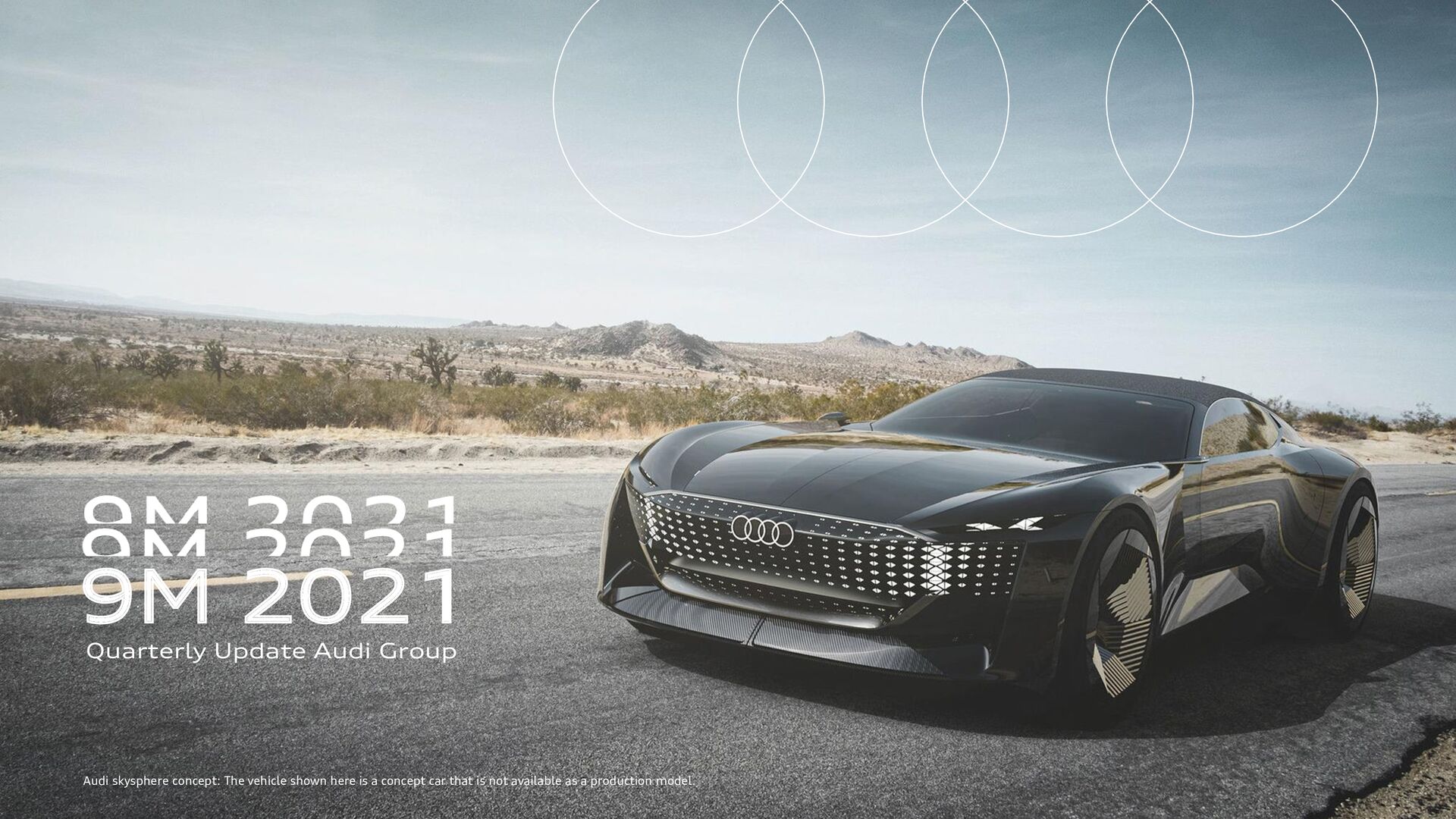 Quarterly Update Audi Group
Quarterly Update Audi Group
The increase in deliveries was coupled with a significant 18.4% growth in revenue in the reporting period. 1–9/2021 1–9/2020 Δ % Urus 4,085 3,278 24.6 Huracán 2,136 1,672 27.8 Aventador 681 681 0.0 Lamborghini brand 6,902 5,631 22.6 1–9/2021 1–9/2020 Δ % Urus 3,879 3,120 24.3 Huracán 1,709 1,395 22.5 Aventador 497 590 -15.8 Lamborghini brand 6,085 5,105 19.2 Deliveries to customers in units Production in units 30% 33% 12% 25% Lamborghini with strong increase in deliveries and revenue China Europe USA Other markets by region Lamborghini Sián Roadster: combined fuel consumption in l/100 km: 19.8 (NEDC); combined CO2 emissions in g/km: 449 1-9/2020 1-9/2021 1,182 1,399 +18.4% Revenue from the sale of cars in €m https://www.audi.com/content/dam/gbp2/de/company/investor-relations/reports-and-key-figures/interim-reports/audi-fact-pack-Q3-2021.xlsx https://www.audi.com/content/dam/gbp2/de/company/investor-relations/reports-and-key-figures/interim-reports/audi-fact-pack-Q3-2021.xlsx 19 Extended CONFIDENTIAL AUDI AG 9M/2021 Quarterly Update Audi Group October 29, 2021 2. Finance and key figures – Ducati The Ducati brand delivered 49,693 (38,796) motorcycles to customers worldwide in the first nine months of 2021 and has already exceeded FY2020. Driven by this increase of 28.1% in deliveries, but also due to an attractive product portfolio and a strong price position, Ducati significantly increased its revenue and operating profit in the reporting period.
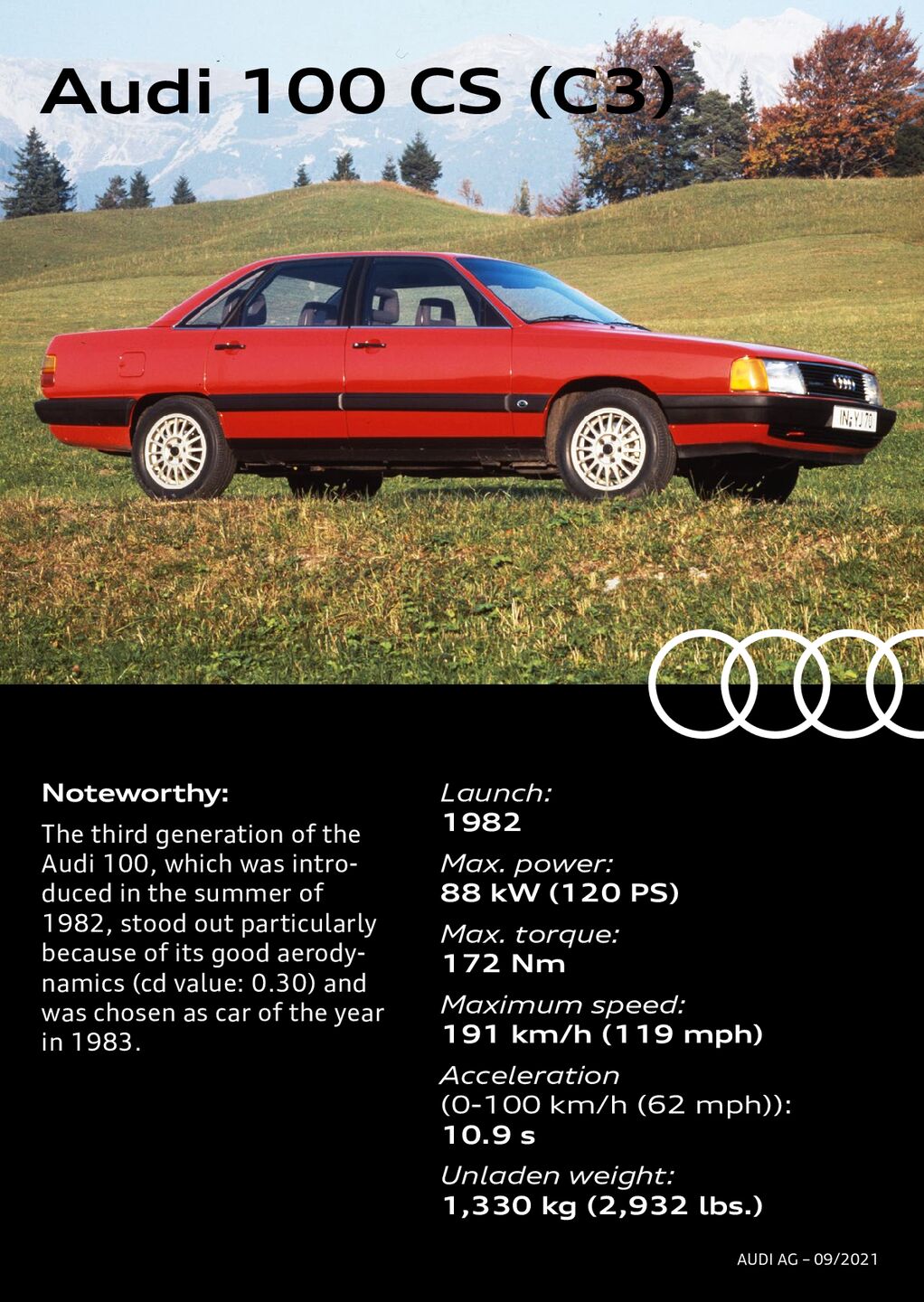 Car quartet
Car quartet
Audi RS 3 Combined fuel consumption in l/100 km: 7.4 (31.8 US mpg); Combined CO 2 emissions in g/km: 170 – 169 (273.6 – 272.0 g/mi) AUDI AG – 09/2021 Noteworthy: The first RS Q3 established its own vehicle segment. In 2019, the second generation was also available as a Sportback. Launch: 2019 Max. power: 294 kW (400 PS) Max. torque: 480 Nm Maximum speed: 250 km/h (155 mph) (fixed) Acceleration (0 –100 km/h (62 mph)): 4.5 s Unladen weight: 1,715 kg (3,780 lbs.) Audi RS Q3 Combined fuel consumption in l/100 km: 9.0 – 8.8 (26.1 – 26.7 US mpg); Combined CO 2 emissions in g/km: 206 – 201 (331.5 – 323.5 g/mi) AUDI AG – 09/2021 Noteworthy: The Q4 e-tron and Q4 Sportback e-tron are convincing due to their high everyday usability and they are Audi’s first electric cars in the compact segment. Launch: 2021 Max. power: Peak electric power 220 kW Max. torque: 460 Nm Maximum speed: 180 km/h (112 mph) Acceleration (0 –100 km/h (62 mph)): 6.2 s Unladen weight: 2,135 kg (4,707 lbs.) Audi Q4 50 e-tron Combined electric power consumption in kWh/100 km (62.1 mi): 18.2 – 16.4 (NEDC); combined CO 2 emissions in g/km (g/mi): 0 AUDI AG – 09/2021 Noteworthy: The e-tron S and e-tron S Sportback were the first electric cars in the world to come out of large-scale production with three electric motors and electric torque vectoring. Launch: 2020 Max. power: Peak electric power 320 kW Max. torque: 973 Nm Maximum speed: 210 km/h (130.5 mph) Acceleration (0 –100 km/h (62 mph)): 5.1 s Unladen weight: 2,620 kg (5,776 lbs.) Audi e-tron S Combined electric power consumption in kWh/100 km (62.1 mi): 26.3 – 24.6 (NEDC); combined CO 2 emissions in g/km (g/mi): 0 AUDI AG – 09/2021 Noteworthy: The RS e-tron GT is as sporty as it is good for everyday driving. When charged with the maximum 270 kW, the batteries reach 80 percent full in just under 23 minutes.
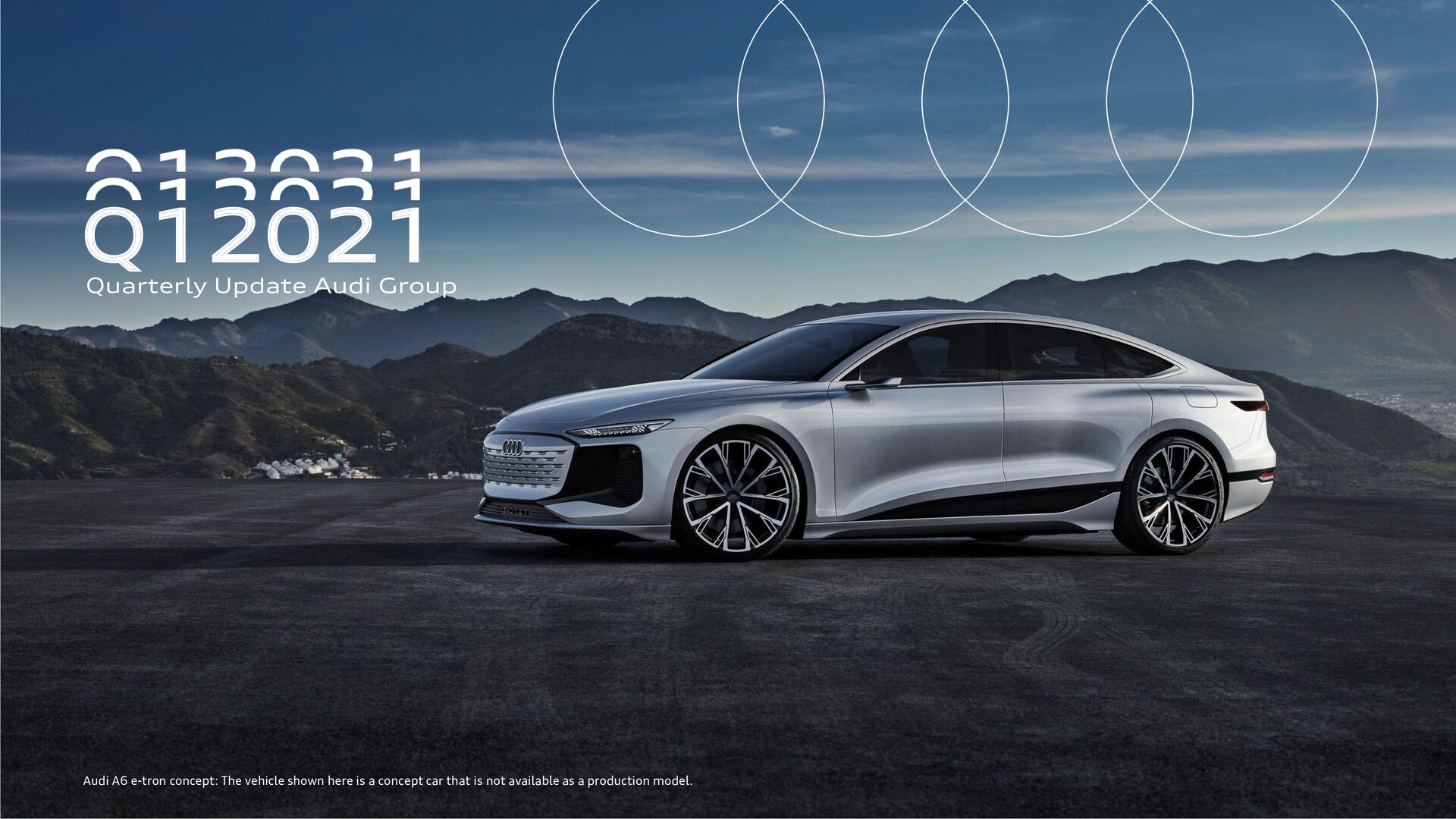 Quarterly Update Audi Group
Quarterly Update Audi Group
The high-voltage battery with a net energy content of 84 kWh enables ranges of up to 488 kilometers (WLTP, for the Audi e-tron GT quattro2) and can be recharged extremely quickly thanks to its 800-volt technology. Suspension, lights, controls, connectivity or e-tron sport sound: The Audi e-tron GT quattro2 and the RS e-tron GT1 demonstrate accumulated technical expertise and the Audi brand’s passion for details. Beginning of a new era: the Audi RS e-tron GT1 and Audi e-tron GT quattro2 1 Audi RS e-tron GT: combined electric power consumption in kWh/100 km: 20.2–19.3 (NEDC); combined CO2 emissions in g/km: 0 (NEDC) Information on fuel/electric power consumption and CO2 emissions in ranges depending on the chosen equipment level of the car. 2 Audi e-tron GT quattro: combined electric power consumption in kWh/100 km: 19.6–18.8 (NEDC); combined CO2 emissions in g/km: 0 (NEDC) Information on fuel/electric power consumption and CO2 emissions in ranges depending on the chosen equipment level of the car. INTERNAL Electric, efficient & emotional: Audi Q4 e-tron & Audi Q4 Sportback e-tron The Audi Q4 e-tron and the Q4 Sportback e-tron are the first compact fully electric SUVs from the brand with the Four Rings. Both of them impress with a new spacious dimension in the interior and pioneering solutions when it comes to operation, display and assist systems. The optional augmented reality head-up display connects the virtual and the real worlds in a totally new way. The Audi Q4 e-tron achieves a maximum range of up to 520 kilometers in the WLTP cycle. It goes on sale in Europe in June 2021. Audi Q4 Sportback e-tronAudi Q4 e-tron INTERNAL New Board members, responsibility for Bentley and NEV company in China The brand with the Four Rings is deepening its partnership with First Automotive Works (FAW) and laying the foundation for continued success in China.
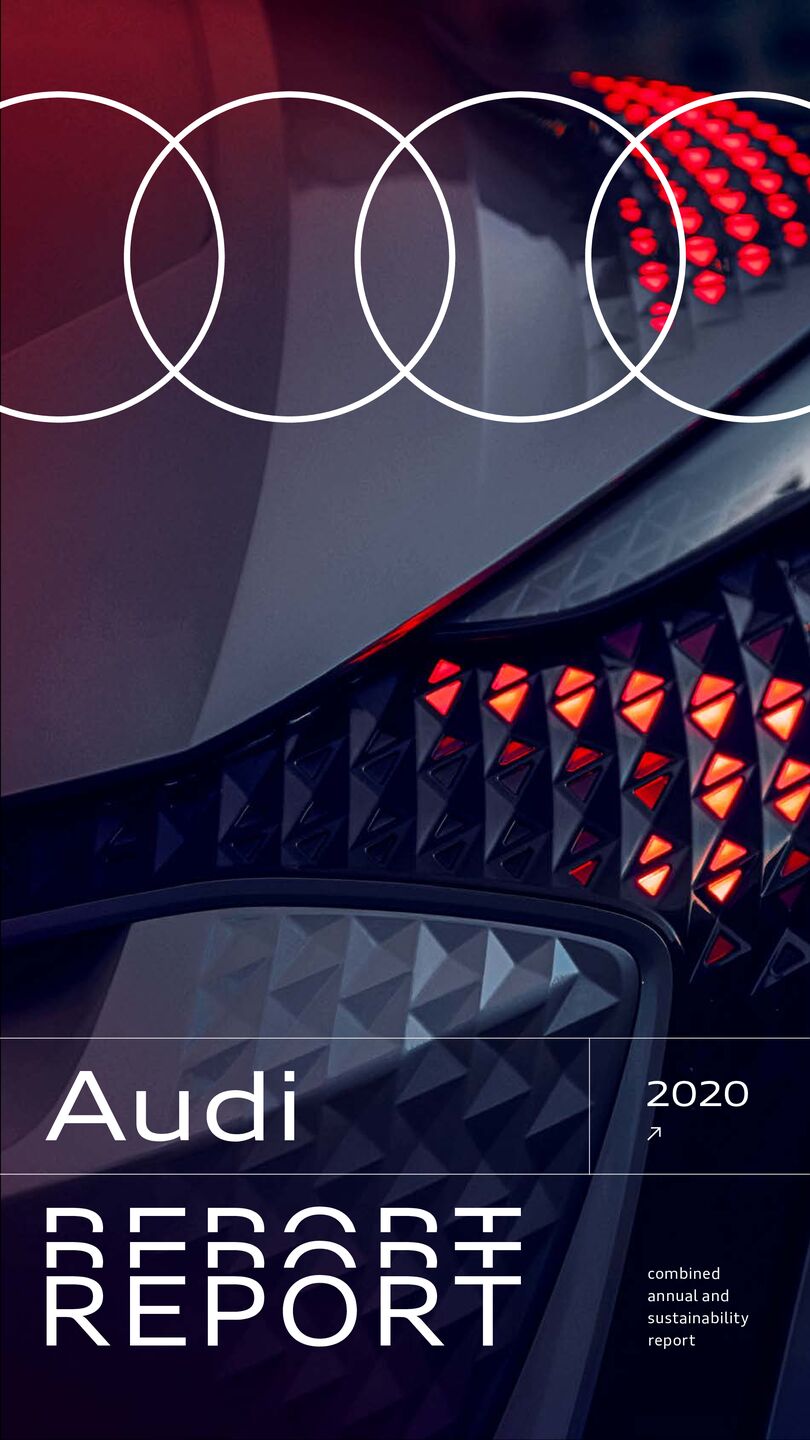 Audi Report 2020
Audi Report 2020
Jan Feb Mar Apr May Jun Jul Aug Sep Oct Nov Dec P h o to : A U D I A G Operations are also reduced to a minimum at the Audi headquarters in Ingolstadt. Audi Report 2020 15 Milestones Audi e-tron Sportback2 takes the virtual world by storm Audi launches the second model of its e-tron product line in a first-ever purely virtual format. The Audi e-tron Sportback2 is a dynamic SUV coupé offering up to 300 kW (407 PS) of power and a range of up to 452 kilometers (WLTP) from a single battery charge. With the two body variants – SUV and Sportback – and two different performance levels, Audi is appealing to a broad range of customers with the e-tron family and continuing to promote its electrification initiative. Next milestone in September: the Audi e-tron S3 and its Sportback version.4 Jan Feb Mar Apr May Jun Jul Aug Sep Oct Nov Dec 2 Audi e-tron Sportback: combined electric power consumption in kWh/100 km: 28.3–20.9 (NEDC); combined CO₂ emissions in g/km: 0 3 Audi e-tron S: combined electric power consumption in kWh/100 km: 28.8–27.1 (NEDC); combined CO₂ emissions in g/km: 0 4 Audi e-tron S Sportback: combined electric power consumption in kWh/100 km: 28.3–26.4 (NEDC); combined CO₂ emissions in g/km: 0 As the first car manufacturer, Audi uses “Virtual Market 4,” one of the biggest virtual reality events in the world, as the presentation and experience platform for the new Audi e-tron Sportback.2 P h o to : A U D I A G Audi Report 2020 16 Milestones P h o to : A U D I A G Audi production gradually starts up again in Europe Audi gradually ramps up production again at its European sites. In close consultation with suppliers and service providers, Audi puts together the necessary measures to comply with health and safety rules aimed at protecting all employees, and arranges a gradual return to daily production at the plants. Jan Feb Mar Apr May Jun Jul Aug Sep Oct Nov Dec Health comes first: plexiglass dividers protect employees working close together in assembly.